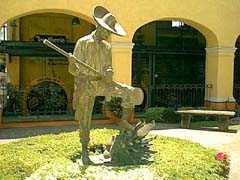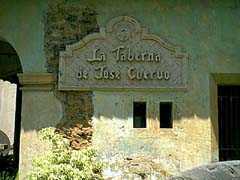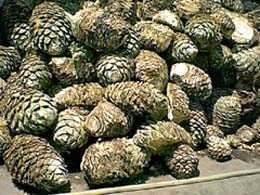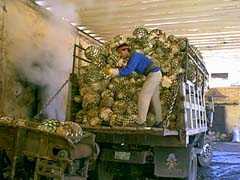Just about an hour from Guadalajara, in the state of Jalisco, there’s a little town (population 17,740) with a big reputation: Tequila.
Meaning “the rock that cuts” in the Nahuatl language, Tequila is the home of the famous Agave Azul cactus. Under the shadow of an extinct 9,000 foot volcano, this is the only place in Mexico where this particular species of agave grows (there are some 136 species of agave). And, according to Mexican law, every bottle of tequila must contain distilled juices from at least 51% of this particular plant. Otherwise, they can’t call it “tequila.”

The Mexican government gives distillers some leeway in the distillation of this world-popular drink. Within the mandatory 51% minimum, they say you can use pure juice (of the agave) or juice “watered down” with cane juice (mixto). Tequila is graded according to how much pure juice is used. In this case, more is definitely better (and more expensive). There’s a Tequila Regulatory Council that monitors the making and labeling of the many kinds of tequila on the market.
Tequila was first distilled in the 16th century. But it wasn’t until the 17th century that the drink began to catch on among the locals (it was the favorite drink among silver miners in nearby Bolanos.) It wasn’t until World War II when this drink caught the eye and the fancy of U.S. servicemen stationed in towns along the border.
Today, Mexico exports around 10 million cases of tequila to the U.S. every year. In all, there are more than 100 countries that import tequila from Mexico. But in Mexico, this sometime clear and other times amber drink is considered a staple, to be drunk straight (from a caballito, a special, cylindrical type of shot glass. But first, you have to lick some salt you’ve sprinkled on the top of your hand (between your thumb and index finger), and then suck a wedge of lime. This is supposed to soften and mellow the edges of this otherwise potent and fiery drink. Or you can try tequila with a sip of lemon juice alternating with a sip of (non-alcoholic) sangrita, a combination of orange and tomato juice.
Tequila is best when made the traditional, “old-fashioned” way: cooking the agave plant in old adobe ovens, then filtering it through cellulose. More modern methods of filtering seem to take the taste away. Or so they say. But in the town of Tequila, where the main industry is the making of the drink of the same name, regardless of how they make it, one could almost get drunk breathing in the vapors drifting from the town’s distilleries.

The two largest distilleries, Sauza and Cuervo, offer free public tours and tastings. The Cuervo family, which goes back to 18th century Seville, was kind enough to host us for lunch, mariachi music and a generous sampling of the different kinds of tequila they make. Other top distilleries in the area are Orendain and Herradura.
Obviously, most tourists wouldn’t come to Tequila just to sample this ancient drink. There are other things to do here, like driving to the top of the volcano for a glorious view of the countryside, or to bird-watch (there are as much as 360 different species). The town of Tequila provides an interesting side trip from the beaches of Puerto Vallarta (minutes away by plane and five hours by car), or a quickie trip from Jalisco’s capital, Guadalajara.
Historical note: during Mexico’s War of Independence (1810-1821), Tequila (the town) was on the route west from Guadalajara to the port of San Blas. As such, merchants from England, France, the U.S. and Panama, came here to trade. Many of the famous brands of Tequila date from this period.
The making of tequila

Although the process varies from distiller to distiller, the basics are pretty much the same: first the agave is allowed to grow for ten years. Then it’s trimmed down to the heart of the plant, the piña (looks very much like a pineapple). Weighing in at about 100 pounds, the piña is then cut in halves or quarters and loaded into the ovens for cooking. The piñas are then crushed to extract all the juices, and then fermented in special tanks. There’s more. Although this liquid can now be called “tequila,” it goes through another distillation process to remove any possible impurities.
What results is a pure and refined top quality tequila blanco. Some of this magic brew is aged in oak kegs for at least two months, turning it a golden, amber color. This type of tequila is called reposado. If you age it for at least one year (often as much as seven years), you get añejo, a darker, richer tequila. Although this process is pretty much the same among most tequila factories, some add water, colors and flavors to make their product more distinctive.

A kissing cousin to tequila, derived from the maguey cactus (the same family as the agave, but grown in areas other than Tequila), is pulque. Pulque is a popular drink that traces its roots to ancient times when it was a ritual beverage.
Mezcal (much of it made in the sate of Oaxaca) is another relative of tequila (and pulque). In comparing tequila to Mezcal, you could say that “Mezcal is to tequila as brandy is to cognac.” Made from an assortment of different agave plants, this harsher-than-tequila drink goes through one distillation process only, making it more potent, with a decided “smoky” taste, the result of baking the piña in an underground kiln. Mezcal, which has its own fan club of “wouldn’t-settle-for-anything-else” aficionados, who adore this drink – with or without a worm inside the bottle (the worm is a creature that feeds on the agave plant which, some say, adds a flavor to the drink. ¿Quien sabe? Who knows for sure?
Both pulque and mezcal, because they are cheaper, are often considered to be the drink of the “blue collar” class. In Mexico, the pulquerías, tavern-like bars where this drink is served, are down-home, friendly places, filled with camaraderie and lots of pulque.
And nor for the margarita
Tequila, lime juice, cointreau and crushed ice – these are the basic ingredients of this much sought after drink. But the proportions vary from bartender to bartender, with the result that sometimes the Margarita is too sweet, or too sour, or just right. There are many legends about where this famous drink came from. Some say that it was named for Margaret Sames, a Texan, who first served the drink in her home in Acapulco. Others say that a bartender in Tijuana had one of his customers in mind, Marjorie Margarita King, when he concocted the drink. It seems that, Ms. King, a budding actress, was only able to drink tequila and Cointreau.
Note: More than 600 million margaritas are consumed in the U.S. every year, about 1½ million every day. But die-hard tequila drinkers say that “margaritas are for sissies and gringo tourists.”

